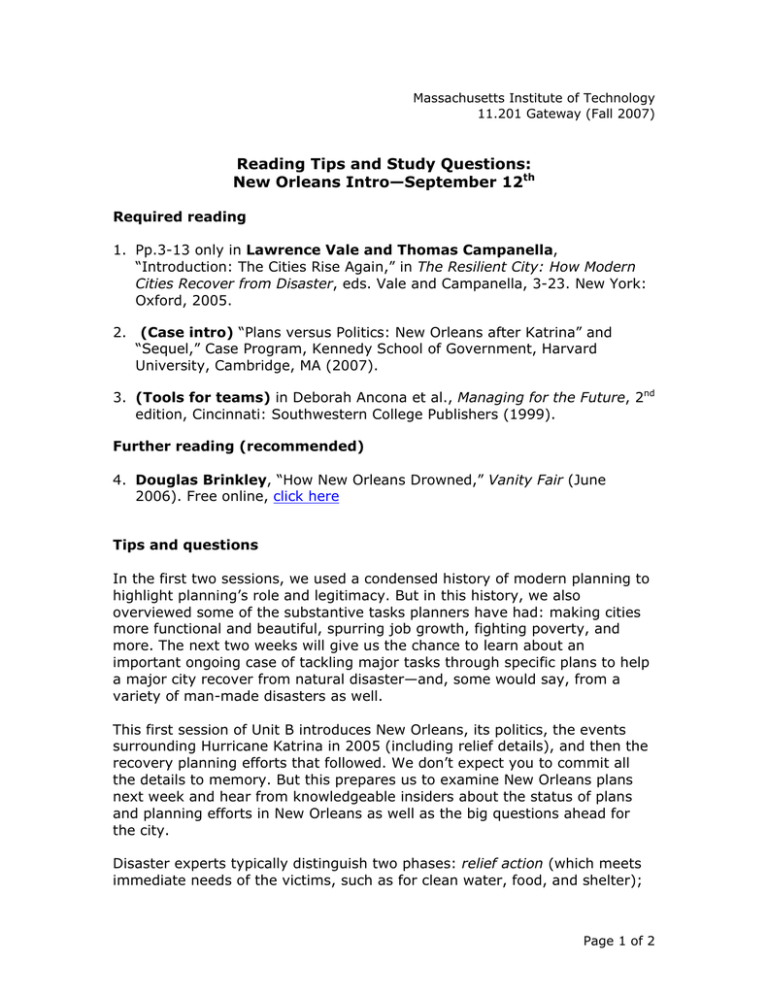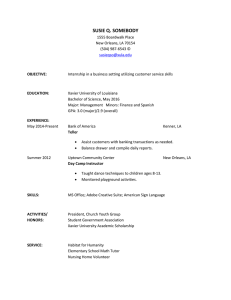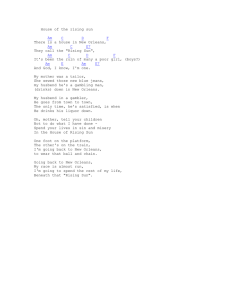Reading Tips and Study Questions: New Orleans Intro—September 12
advertisement

Massachusetts Institute of Technology 11.201 Gateway (Fall 2007) Reading Tips and Study Questions: New Orleans Intro—September 12th Required reading 1. Pp.3-13 only in Lawrence Vale and Thomas Campanella, “Introduction: The Cities Rise Again,” in The Resilient City: How Modern Cities Recover from Disaster, eds. Vale and Campanella, 3-23. New York: Oxford, 2005. 2. (Case intro) “Plans versus Politics: New Orleans after Katrina” and “Sequel,” Case Program, Kennedy School of Government, Harvard University, Cambridge, MA (2007). 3. (Tools for teams) in Deborah Ancona et al., Managing for the Future, 2nd edition, Cincinnati: Southwestern College Publishers (1999). Further reading (recommended) 4. Douglas Brinkley, “How New Orleans Drowned,” Vanity Fair (June 2006). Free online, click here Tips and questions In the first two sessions, we used a condensed history of modern planning to highlight planning’s role and legitimacy. But in this history, we also overviewed some of the substantive tasks planners have had: making cities more functional and beautiful, spurring job growth, fighting poverty, and more. The next two weeks will give us the chance to learn about an important ongoing case of tackling major tasks through specific plans to help a major city recover from natural disaster—and, some would say, from a variety of man-made disasters as well. This first session of Unit B introduces New Orleans, its politics, the events surrounding Hurricane Katrina in 2005 (including relief details), and then the recovery planning efforts that followed. We don’t expect you to commit all the details to memory. But this prepares us to examine New Orleans plans next week and hear from knowledgeable insiders about the status of plans and planning efforts in New Orleans as well as the big questions ahead for the city. Disaster experts typically distinguish two phases: relief action (which meets immediate needs of the victims, such as for clean water, food, and shelter); Page 1 of 2 and recovery and reconstruction, which restores the longer-term bases of people’s lives, from economic livelihoods to housing to valued cultural heritage and more. Our work will focus on planning in the second phase. Finally, please sit in your team groupings when you come to class for this session (see Q3 below). Questions for class prep and discussion sections: 1. Why, according to Vale and Campanella, are modern cities so resilient? Why do they “rise again” after disasters across the world? In light of the historical material we covered in the last session, what important questions for planning (generally) are captured in their brief commentary on “Assessing recovery” after disasters? 2. In the Plans versus Politics case, should the city government have backed the “rational” ULI “green-dot” strategy? Why or why not? What new challenges appeared after the rejection of that plan, that is, when many different players in the city planned recovery? (Note that the United New Orleans Plan will be an important focus for us next week.) 3. Lastly, read the Tools for Teams, created by researchers and educators at the MIT Leadership Center. We won’t collect your “cognitive style” selfassessment, so just use it to spark some reflection about your style. We’ll make time in this assignment kick-off session for you to gather as a team and start with basic questions, such as “What do your team members need to know about you in order to work effectively with you?” and “How do we want to organize deadlines leading up to the dry run?” and “How might we want to divide the labor?” plus the all-important “When do we meet next?!?” On the further reading: 4. Brinkley’s Vanity Fair article offers exceptional detail on the days right before and after the storm. And it is not flattering to New Orleans Mayor Ray Nagin. Who backed his entry into office, and what key political considerations shaped his actions in the wake of the storm, according to Brinkley? What other political players, at several levels of government, does Brinkley spotlight as important to the events in New Orleans? Page 2 of 2






